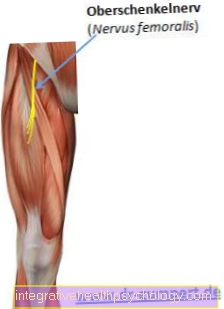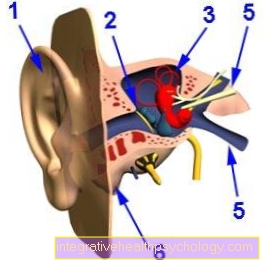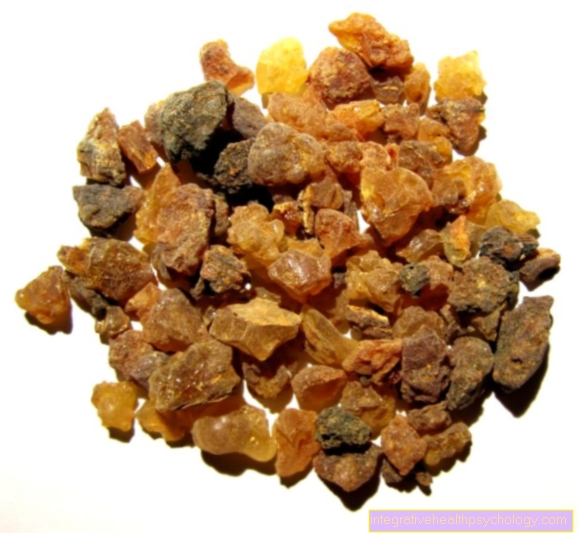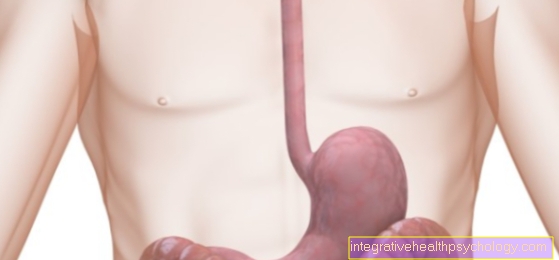Lidocaine spray
definition
Lidocaine belongs to the group of local anesthetics.
They are used to block the transmission of impulses in the nerve. This suppresses the sensation of pain, thus creating a local anesthetic. The special thing about lidocaine is that it is also a drug that is used in the therapy of extra heart beats. Lidocaine is often used as a spray on the skin to reduce pain. It is also known to be used in otolaryngology and dentistry.
Also read more about: Local anesthetics - the local anesthetic

Indications for the lidocaine spray
Lidocaine spray can be used for superficial anesthesia on the skin.
Indications for this are, for example, the cleaning of abrasions or burns of limited size. In the field of ear, nose and throat medicine, the spray can be used for diseases of the auricle or the external auditory canal. If an incision in the eardrum is necessary, local anesthesia using the lidocaine spray can also be used for this indication. Further areas of application are in the area of the nose and the nasal passage. In addition, if a sample has to be taken (biopsy) from the oral cavity or the throat area, the previous local anesthetic can be carried out using the lidocaine spray.
In dentistry there are also a large number of indications for the lidocaine spray. For example, when removing tartar, residual roots, milk teeth or during minor surgical interventions, the spray can be used to achieve anesthesia, making the operation more comfortable for the patient. The fitting of prostheses or other orthodontic work as well as increased nausea can be indications for the lidocaine spray.
Also read:
- Lidocaine ointment
- Lidocaine when inserting a nasogastric tube
Lidocaine spray for a sore throat
For a sore throat, a numbing lidocaine spray can be used to relieve pain. This also applies to inflammation in the throat area that is not based on a cold.
It is important to use the spray for a short period of time and to support it. According to GP guidelines, lozenges with lidocaine as an additive are recommended rather than a spray. It is emphasized that these lozenges should only be used for short-term use. In addition, the benefit due to the risk of allergic reactions must be questioned, which applies to the spray.
Lidocaine spray when tattooing
When tattooing, lidocaine can be applied to the skin as a spray or as an ointment. This is supposed to make the painful process of tattooing more comfortable for the client.
The literature does not specify when the local anesthetic is used. This means that it can be used even before the process, as well as during or after the tattooing. In general, care should be taken that when using a lidocaine spray or another carrier substance for the lidocaine, sterility can be guaranteed in order to exclude infections. A lidocaine spray should also be avoided if you have a known lidocaine allergy.
Lidocaine spray for migraines
The effectiveness of lidocaine spray for migraines has not yet been scientifically proven. It is therefore not recommended so far, also for the reason that the spray does not reach the regions that are associated with the triggering of the pain.
However, there are experimental therapeutic approaches in which the lidocaine is brought to the nerve node of the alar fossa via a small tube in the nasal cavity, which is suspected of having a triggering connection with the migraine.
Learn more about: Beta blockers for migraine prophylaxis
Lidocaine spray for cluster headache
For cluster headache attacks, lidocaine spray can be applied to the nasal cavity of the affected side.
In order to achieve an even better effect, it is recommended to use a nasal pipette to introduce a lidocaine solution as deeply as possible into the nasal cavity. This therapeutic approach can help to improve patients who have a contraindication to triptans, which are the drugs of first choice. Anesthesia of the nerve tracts in the alar fossa is assumed to be the mechanism of action.
Also read: Triptans
How does the lidocaine spray work exactly?
The lidocaine spray is absorbed by the skin or the mucous membranes and then unfolds its effect in the area of the local nerve fibers.
The active ingredient blocks the sodium channels in nerve fibers. Nerves transmit information via electrical potentials. The sodium channels are essential for this function. If the sodium channels are now blocked, a subsequently set pain stimulus can no longer be passed on to the brain, since the nerve fiber in the area of the pain stimulus can no longer build up electrical potentials. One then speaks of a reduced conductivity of the nerve fiber. This means that information no longer flows from the affected area towards the brain, where a pain sensation would first have to be processed so that it can penetrate consciousness.
How long does lidocaine last?
The duration of action is approximately two hours. This period can be influenced by various factors. The dosage and the absorption capacity of the tissue play a role here. Furthermore, lidocaine is broken down by the liver, so that the breakdown is slowed down in patients with liver diseases and the duration of action can be extended.
What are the side effects of the lidocaine spray?
In addition to the allergy, skin and mucous membrane irritation can occur, especially in the areas where the spray has been applied.
When used in the mouth and throat area, swelling may occasionally occur. These usually go away within a few days and do not require any further therapy. If the swelling occurs in the area of the larynx, it may cause temporary hoarseness.
In the event of an overdose of the spray, the active ingredient can pass into the bloodstream and trigger poisoning, which manifests itself particularly with symptoms in the heart.
You might also be interested in: Side effects of local anesthetics
What happens if you have an allergy to lidocaine?
An allergic reaction to lidocaine is possible and can lead to a severe hypersensitivity reaction and anaphylactic shock.
A shock is a condition in which the body's own tissues can no longer be adequately supplied with oxygen. In the case of lidocaine, this is triggered by an excessive allergic reaction. This is characterized by swelling of the skin or mucous membranes that have come into contact with lidocaine, as well as reddening and possibly also itching.
If an allergy to the local anesthetic is known, a different active ingredient should be used if possible. Often, however, an untested allergy to lidocaine turns out to be false.
Can you buy lidocaine spray without a prescription?
Lidocaine spray is available without a prescription in pharmacies and online pharmacies in different solutions and in different but relatively small dosages.
The various sprays also differ in their area of indication. Sprays are offered specifically for dentistry or for sore throats. Nevertheless, the use of lidocaine spray should always be discussed with a doctor and the application time should always be limited to the shortest possible time in order to prevent serious side effects such as symptoms of poisoning or allergic reactions.




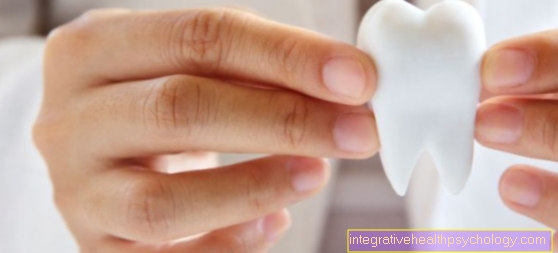


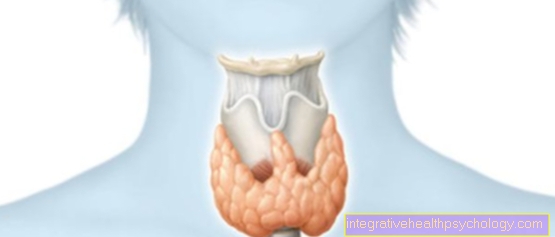






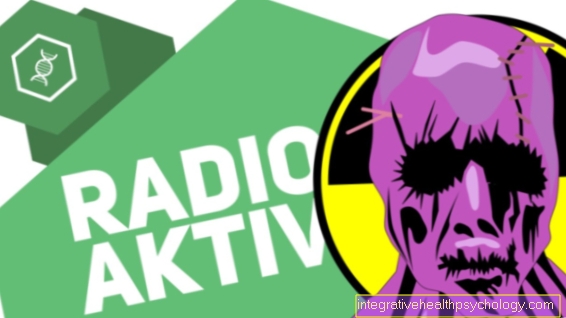

.jpg)




